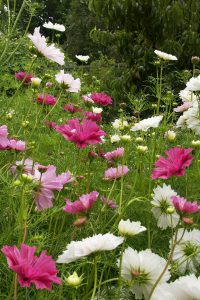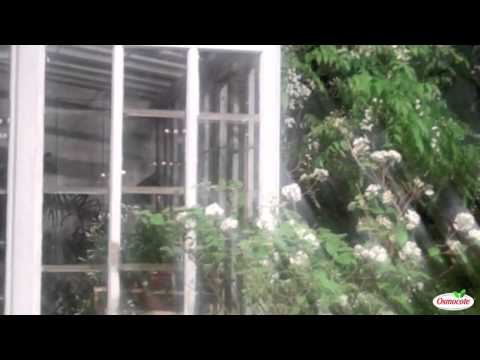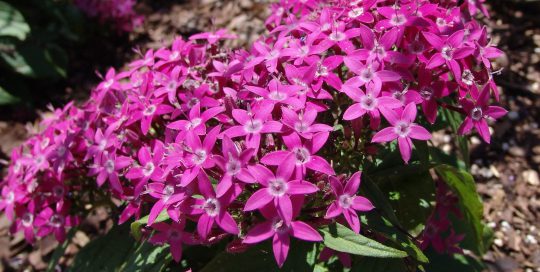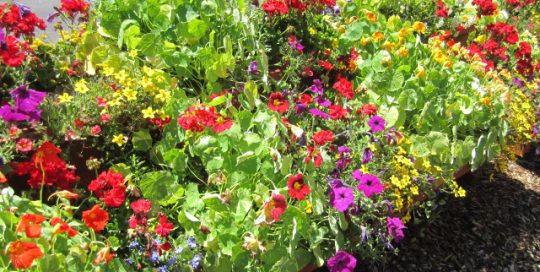12 Popular Cottage Garden Flowers
Here are some of my sun-loving, cottage garden favorites.
-
Cosmos — These bright, colorful annuals can reach anywhere from 10 inches tall to more than four feet. Blossoms may be white, pink, violet or magenta and single or double. The flowers can be used for bouquets, and in late summer, the goldfinches feed the seeds to their young.
 Cosmos – Photo by Nina Koziol
Cosmos – Photo by Nina Koziol - Zinnias — These annuals are the quintessential cottage garden flower in our garden. Breeders have been busy creating new varieties with single and double flowers in a wide range of colors. They are butterfly magnets, especially in late summer when monarch butterflies are migrating.
- Sunflowers — What’s not to like about charming, bright blossoms? Easy to grow from seed, sunflowers come in variety of colors that range from bright buttery yellow to red, red and yellow, deep orange, and creamy white. Flowers can be single, semi-double or, like Teddy Bear sunflower, fully double, 6-inch-wide blooms. Dwarf plants may be as short as 20 inches while mammoth sunflowers can reach 12 feet tall.
- Nasturtium — Easy to grow from seed, nasturtiums offer edible blooms and buds with a peppery or mustard-like flavor. They’re easy to grow from seed—I soak them for two hours before planting.
- Buddleia — Butterfly bush grows throughout our sun-loving flower beds. Its extremely fragrant flowers — purple, violet, white, pink or red-pink — attract hummingbirds and butterflies galore. As soon as the cone-shaped flowers are finished, I remove the seed heads (deadheading) and another flush of bloom takes place.
-
Dahlia — Bold and vibrant, dahlia flowers can be small or the size of a dinner plate. I use the shorter varieties in the front of flower beds with taller varieties in the back of the border. They bloom from June through mid-October and are great in bouquets.
- Salvia — Annuals or perennials, salvia comes in blue, violet, white, pink or red flowers. Salvia ‘Victoria’ stands 16 inches tall and 12 inches wide, and attracts bees and butterflies galore.
- Four O’Clocks — These annuals thrive in full sun and poor, dry soil. The fragrant, trumpet flowers open in late afternoon (thus their name) and they attract hummingbirds and other pollinators. Easy to grow from seed—just direct sow the seeds once there is no danger of spring frost.
- Nepeta — Catmint is a wonderful, long-blooming perennial for the cottage garden. Plant it around shrub roses or with daisies, coneflowers, black-eyed Susan or sunflowers for a long floral show.
- Lavender — A cottage garden favorite that offers fragrance while resisting pests and disease. In the spring, I use hedge clippers to cut off dead stems, leaving the plant about six inches tall. Give lavender a spot in full sun with well-drained soil. Grow it along a sidewalk, patio or path where the reflected heat creates conditions that this plant prefers. One of my favorite combinations is lavender with Pink Delight roses.
- Cleome — This annual is often called spider flower for the masses of spider-shaped white, rose or violet blossoms. Cleome self-sows in our borders where it becomes a pop-up plant among the other flowers.
- Dill — Herbs are an integral part of the cottage garden. I sow seeds of dill, fennel and parsley for use as fillers throughout the sunny areas. They are fragrant and useful in the kitchen and in bouquets, but I mostly grow them because they are magnets for black swallowtail butterflies. The butterflies lay their eggs on the plants, which are host plants for the caterpillars. When dill and fennel flower later in the summer, they are covered with tiny bees.








